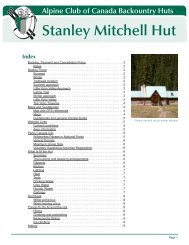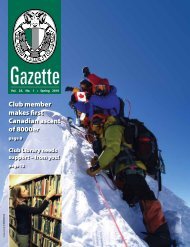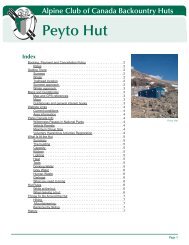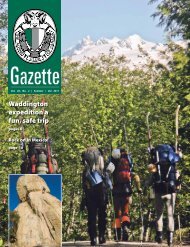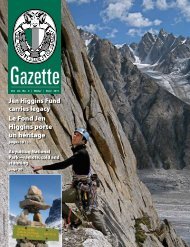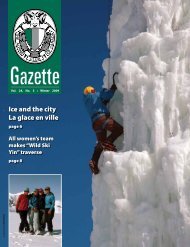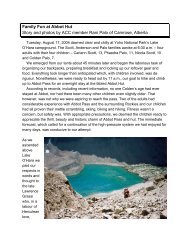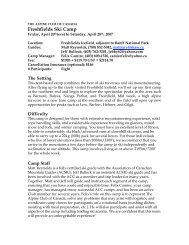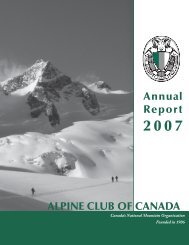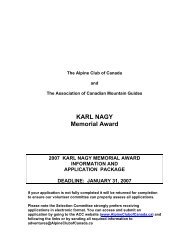Winter 2010 - The Alpine Club of Canada
Winter 2010 - The Alpine Club of Canada
Winter 2010 - The Alpine Club of Canada
- No tags were found...
You also want an ePaper? Increase the reach of your titles
YUMPU automatically turns print PDFs into web optimized ePapers that Google loves.
Peter Fuhrmann awarded Summit <strong>of</strong> Excellence<br />
by Lynn Martel<br />
At the height <strong>of</strong> the summer<br />
climbing season in August 1971,<br />
the Banff Park warden service<br />
received a call that an army cadet had<br />
been struck by falling rock while climbing<br />
on Mount Edith. By good fortune,<br />
the public safety team, led by Peter<br />
Fuhrmann, Parks’ alpine specialist for<br />
western <strong>Canada</strong>, was practicing rescue<br />
techniques with the aid <strong>of</strong> a helicopter,<br />
a system Fuhrmann had recently been<br />
introduced to while visiting a friend in<br />
Munich during a family vacation. With<br />
a helicopter, a sling and a stretcher, the<br />
injured cadet was flown to nearby Banff<br />
Mineral Springs Hospital in less than<br />
an hour. With a traditional land rescue<br />
taking hours to carry out, no doubt<br />
the cadet, suffering from serious head<br />
trauma, was saved from succumbing from<br />
his injuries. <strong>The</strong> modern technology <strong>of</strong><br />
helicopter-assisted mountain rescue had<br />
arrived in <strong>Canada</strong>.<br />
Now, four decades later, techniques<br />
and systems developed by Fuhrmann and<br />
his colleagues—including Willi Pfisterer,<br />
who served as Parks <strong>Canada</strong>’s alpine specialist<br />
for Jasper, Waterton, Revelstoke/<br />
Glacier and Kluane parks—have since<br />
helped save hundreds <strong>of</strong> lives in Canadian<br />
national parks and wilderness areas.<br />
Fuhrmann is recognized for modernizing<br />
rescue training techniques within the<br />
mountain parks, introducing the helicopter<br />
sling and for taking generations<br />
<strong>of</strong> young wardens on gruelling training<br />
missions dubbed “Fuhrmann Sanctions”.<br />
He also introduced the idea <strong>of</strong> helicopter<br />
Participants on Week 5 <strong>of</strong> the <strong>2010</strong><br />
General Mountaineering Camp<br />
(GMC), which took place in the<br />
Battle Brook Range <strong>of</strong> BC’s Columbia<br />
Mountains, were thrilled to find treasure<br />
in the summit cairn on Grand Mountain.<br />
Inside the cairn was tucked a small, rusty<br />
tin which appeared to contain the summit<br />
registry.<br />
Upon opening the tin, they discovered<br />
only three entries inside—one from 1976,<br />
one from 1955 and, most remarkably,<br />
a business card belonging to Howard<br />
Palmer. On it he and E. Holway recorded<br />
the first ascent <strong>of</strong> the peak in August, 1910.<br />
26 <strong>Alpine</strong> <strong>Club</strong> <strong>of</strong> <strong>Canada</strong> Gazette <strong>Winter</strong> <strong>2010</strong><br />
bombing for avalanche control, and<br />
many <strong>of</strong> his rescue techniques have been<br />
adopted by rescue teams throughout<br />
North America.<br />
In recognition <strong>of</strong> his numerous contributions,<br />
Fuhrmann, a dedicated member<br />
<strong>of</strong> the Canadian mountain community<br />
for six decades, was named recipient<br />
<strong>of</strong> the <strong>2010</strong> Summit <strong>of</strong> Excellence<br />
(SOE) Award. Sponsored by Canadian<br />
Mountain Holidays, the SOE is presented<br />
annually on closing night <strong>of</strong> the<br />
Banff Mountain Film Festival to a person<br />
who has made a significant contribution<br />
to mountain life in the Canadian Rockies.<br />
Disillusioned with post WWII<br />
corporate politics after being recruited<br />
for a management position by Shell Oil,<br />
Fuhrmann arrived in Banff from his native<br />
Germany in 1955. He worked on a survey<br />
crew and as a regional draughtsman for<br />
the department <strong>of</strong> public works before<br />
earning his Parks mountain guide license<br />
in 1961, the same year he joined the <strong>Alpine</strong><br />
<strong>Club</strong> <strong>of</strong> <strong>Canada</strong> (ACC). He guided on the<br />
ACC’s Yukon Centennial Camp in 1967,<br />
led climbs in Peru and the Himalaya and<br />
was a founding member <strong>of</strong> the Association<br />
<strong>of</strong> Canadian Mountain Guides (ACMG),<br />
which was formed in 1963.<br />
He worked with Parks’ first alpine<br />
specialist Walter Perren, helping to train<br />
horseback-riding wardens in climbing<br />
rescue techniques. After Perren died <strong>of</strong><br />
illness, in 1968 Fuhrmann became Parks’<br />
alpine specialist for western <strong>Canada</strong>—a<br />
position which eventually included<br />
Cape Breton Highlands, Gros Morne,<br />
Auyuittuq-Baffin Island, Ellesmere<br />
Island, Pacific Rim and South Moresby<br />
parks.<br />
A tireless advocate for high alpine<br />
recreation and safe guiding practices in<br />
the parks, Fuhrmann served as president,<br />
secretary treasurer and examiner for the<br />
ACMG. Starting with Balfour in 1965,<br />
he was instrumental in the conception,<br />
planning and construction <strong>of</strong> high alpine<br />
shelters on the Wapta Icefield. Believing<br />
the Canadian Rockies had everything<br />
to <strong>of</strong>fer that Europe’s Alps did for the<br />
development <strong>of</strong> multi-day glacier ski<br />
traverses, Fuhrmann played a major role<br />
in developing the ACC’s backcountry hut<br />
system.<br />
Serving as ACC president from 1984<br />
thru 1988, Fuhrmann’s efforts and expertise<br />
helped revitalize the then struggling<br />
national climbing club, strengthening<br />
management and modernizing its<br />
activities to attract new members. He<br />
also nurtured the ACC/Hostelling<br />
International partnership that led to<br />
the creation <strong>of</strong> the popular Lake Louise<br />
<strong>Alpine</strong> Centre. His involvement with the<br />
Town <strong>of</strong> Banff ’s hospital board led to the<br />
relocation and expansion <strong>of</strong> the Mineral<br />
Springs Hospital.<br />
“Peter is incredibly deserving <strong>of</strong> this<br />
honour,” said SOE committee member<br />
Nancy Hansen. “He has contributed to<br />
our mountain community in a variety <strong>of</strong><br />
invaluable ways throughout his entire<br />
life.”<br />
Reprinted with permission from the<br />
Rocky Mountain Outlook.<br />
Summit cairn contains rare treasure at GMC<br />
“It was a pretty special moment to<br />
realize that we had arrived on top within<br />
a couple <strong>of</strong> weeks <strong>of</strong> the 100th anniversary<br />
<strong>of</strong> the first ascent <strong>of</strong> this peak!” said<br />
ACMG guide Jeremy Mackenzie. “Those<br />
guys were tough! We recorded our names<br />
in the registry (and those <strong>of</strong> the other<br />
successful GMCers from earlier in the<br />
week), and then returned the tin and its<br />
contents to the cairn.”



